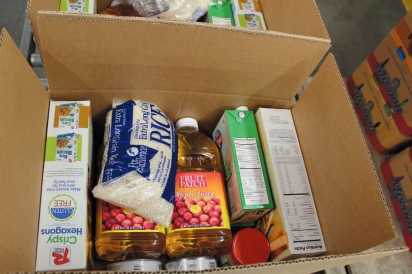Getting Snap-ped
Food insecurity is real, with or without the Farm Bill
William White, a homeless man coming out of the Human Services Agency office in Ventura, has only good things to say about the CalFresh food assistance program.
“I’ve been on CalFresh for a while,” he says. “The help is real. I’m homeless, but I’ll get by, with the help of God and the good people of California.”
Though the State of California administers what once was called food stamps and is now called CalFresh, the benefits for people like White and thousands of low-income households— which add up to more than $97 million annually for recipients in Ventura County—are paid for by the federal government. These have been targeted for cutbacks and radical makeovers this spring by the Republican-controlled House and the Trump White House.
“Congress is taking an ax to the program,” says Monica White, president and CEO of FOOD Share, Ventura County’s food bank, during an April conversation. “It’s going to affect children, seniors and veterans. We know that if this passes it will increase the demand at our FOOD Share pantries in Ventura County.”
Funding for the federal Farm Bill, which encompasses agriculture (such as crop support and insurance) and nutrition aid programs (the Supplemental Nutrition Assistance Program, or SNAP*; CalFresh is the state’s SNAP program), will expire at the end of September if not reauthorized as it must be every five years. The food aid program comprises about 80% of funding for the overall Farm Bill.
Leading up to the vote, there has been a lot of political wrangling and areas of concern for food-insecure people who could be affected here and nationwide.
In February, Secretary of Agriculture Sonny Perdue promoted a radical change in the nutritional aid program. The plan would replace a portion of the current electronic benefits card, where families can purchase a designated amount of groceries at a store, with a “USDA Foods Harvest Box” filled with commodities and canned goods. After widespread criticism—including from anti-hunger advocates and the supermarket industry—the “Harvest Box” idea was dropped.
On April 10, as part of the Republican package to remake SNAP benefits, President Trump signed an executive order with little fanfare. It calls for “reducing poverty in America by promoting opportunity and economic mobility,” and compels departments such as the USDA to institute work requirements that would prevent able-bodied adults up to age 59 from receiving benefits from programs such as SNAP and Medicaid if they do not prove they logged 20 hours of work or training each week.
As part of the proposed reauthorization of the Farm Bill, the House Agriculture Committee this spring passed a measure to tighten income limits and impose new work requirements on adult recipients of SNAP. Jared Call, a leading voice for the nonprofit California Food Policy Advocates, expressed alarm at imposing strict new requirements to ban recipients from benefits for one to three years if they failed to meet strict work requirements, or couldn’t prove their hours.
“We think this rule is harsh and punitive and counterproductive for people who are already out there looking for work, or working part-time with little or no control over their work schedule, a situation many part-time workers face,” says Call.
The Farm Bill failed to pass the House on an early vote in mid-May, after the Freedom Caucus attached an immigration measure to the bill, against the wishes of House Speaker Paul Ryan and the GOP leadership. Legislation that ultimately makes it to Trump’s desk will likely look more like the bipartisan bill being considered by the Senate. Sixty votes will be necessary for passage in the Senate, where Democrats—and some Republicans—oppose drastic changes to the SNAP program.
Since the recession a decade ago, federally funded but state administered programs that reduce hunger have become a central part of the safety net for both agriculture and low-income families.
Nationwide, 42 million people received SNAP benefits at some point in 2017, about 13% of the population, which is nearly double the per capita rate of participation in Ventura County.
In the state, as in Ventura County, the overall numbers of SNAP/ CalFresh recipients have more than doubled in a decade, going from about 2.1 million in June 2007 to a peak of about 4.4 million in summer 2015. As the employment rate has risen in recent years, the number of recipients has begun to come down, by about 11% since 2015.
The recession and the high rate of child poverty in California get most of the credit—or blame—for the growth in the CalFresh program.
California has one of the highest rates of child poverty in the nation, though it varies substantially by location, even within counties. Here, over 40% of children age 5 or younger in 2015 in Ojai, Santa Paula, Oxnard, Port Hueneme and Fillmore were considered poor, according to a Public Policy Institute of California analysis of census numbers. By contrast, just 16% of young children in Thousand Oaks were considered poor.
“There is hunger in Ventura County,” says White of FOOD Share, which works with nearly 200 food pantry and program partners to serve about 74,500 people a month, all over the county.
“Food insecurity is prevalent,” she adds, “but most of the people who come into our pantries only visit once or twice a year. It’s mostly working families who unexpectedly need help at the end of the month, often due to a setback like a car accident, a medical bill or a divorce. We bridge the gap.”
Changes in the way CalFresh and social services agencies in California have administered the program have made food benefits substantially more available to households. Since 2003, California has gone from being one of the least helpful to applicants of all states to one of the most helpful of all states, according to an index of the availability of nutrition benefits compiled by the U.S. Department of Agriculture, which oversees the SNAP program.
Most of the beneficiaries, then and now, are children. Of the 70,106 recipients of SNAP benefits in Ventura County in April this year, 36,688 were 19 years old or younger, according to the Human Services Agency of Ventura County. The benefit totals an average of $123.60 a month per recipient, or $1.37 a meal. (You have to get pretty creative to serve a healthy, nutritious and tasty meal for that amount.)
“Locally, the unemployment rate registered below 5% in 2007 before the recession, but rose above 10% in 2010 when the recession officially ended,” says Jennie Pittman, an administrator with Ventura County’s Human Services Agency. “During that same period, Cal- Fresh participants increased by 80%. As the unemployment rate declined after 2010, CalFresh participation continued to rise for another five years, eventually peaking in late 2015 at 80,000 participants.”
“Given the political climate, it’s been difficult,” says Genevieve Flores-Haro, associate director of MICOP, a support group for thousands of indigenous “Mixtecs” from Oaxaca, most of whom speak neither Spanish nor English. “We see a lot of people who may not want to apply for government aid because of their immigration status. Having someone who speaks your language and isn’t from the government helps put people at ease.”
“MICOP’s outreach services were very helpful in reaching the Mixteco population,” says Pittman, who explained that the county had to reduce funding as the economy improved and caseloads declined. She stresses that the agency continued to support Mixteco outreach and translation services for the indigenous population.
SNAP benefits, which are loaded on to Electronic Benefit Transfer (EBT) cards, can be used for fresh foods at farmers’ markets, as well as at conventional markets. Karen Wetzel Schott, who oversees three farmers’ markets in the county and one in Santa Clarita, says that many more recipients are taking advantage of the ability to buy fresh fruits and vegetables at the markets, totalling $50,000 in 2017.
According to Cynthia Korman, who manages the Ojai Certified Farmers’ Market, it’s busier early in the month, when the benefits first come in. “People are very happy to be able to buy fresh organic foods here. I think that’s a big part of the draw of our market. This program is beneficial to our local growers and supports our local farmers and food system.”
Kristin Schumacher, an experienced analyst in food policy and budget questions with the California Budget & Policy Center, puts the CalFresh policy questions into perspective.
“California is a progressive state where many policy makers and administrators are working to help families that are struggling to make ends meet,” she says. “We all want to have a prosperous state where children aren’t hungry, and where people have decent lives and opportunity. Policymakers have taken steps in recent years to improve participation in the CalFresh program.”
Congress is expected to continue debating the cutbacks and new restrictions on food benefits into the 11th hour in September, when the existing five-year authorization of the Farm Bill will run out.
Editor’s Note: The information provided is current to mid-May when we went to print and we acknowledge that the bill could look very different by September. We’re presenting this now so that you can be aware of what’s happening and contact your elected officials, should you choose to do so.
*Noted as an “anti-hunger program,” SNAP assists low-income families, seniors, children and people with disabilities.







